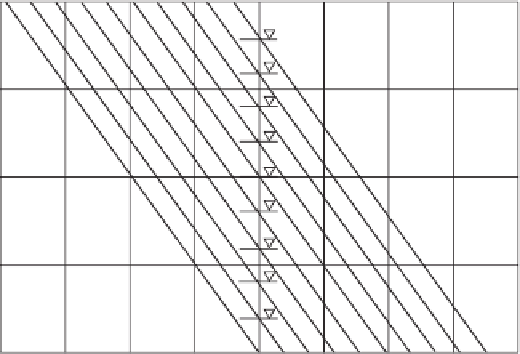Environmental Engineering Reference
In-Depth Information
0
5
10
15
20
−
200
−
150
−
100
−
50
0
50
100
150
200
Pore-water pressure, kPa
Figure 4.97
Equilibrium hydrostatic pore-water pressures for various depths of water table.
suction between the air-entry value and residual conditions
(Fredlund et al., 2007). The retrieval of water content sam-
ples from the field does not provide an indication of whether
the in situ soil is on the drying curve, the wetting curve, or
somewhere in between these two limiting conditions. Soil
suction varies on a logarithm scale with water content, which
also makes it more difficult to obtain an accurate estimation
of in situ soil suction.
The assumption must be made that the geotechnical engi-
neer has either measured or estimated the drying SWCC
for a particular soil deposit. The wetting SWCC branch can
either be measured in the laboratory or estimated based on
suggested empirical guidelines (Pham, 2002). The SWCC
can be plotted as (gravimetric) water content versus loga-
rithm of soil suction (Fig. 4.98). There are two points along
the SWCC that are pivotal to describing the SWCC: the
“air-entry value” of the soil and “residual conditions.”
The SWCC is not a single-valued, unique relationship but
rather is hysteretic, as shown in Fig. 4.99. Therefore, it is
not possible to determine a single soil suction value based
on a single water content measurement. Several observations
can be made from the drying and wetting SWCCs. First, the
hysteresis loops appear to be generally quite reproducible
during repeated drying and wetting cycles. Second, some
air becomes entrapped in the soil after it is wetted from
a high-suction stress state. Third, the slope of the desorp-
tion curve is approximately parallel to that of the adsorption
curve when the soil has been dried to a point beyond resid-
ual suction. Each of the bounding SWCCs has an inflection
point of maximum slope on a logarithmic scale. The inflec-
tion point can be used as a point to define the lateral shift
between the drying and wetting SWCCs.
1. Ignore the effect of hysteresis and solely use desorption
SWCCs for the estimation of soil suction (i.e., the
upper bounding branch of the SWCCs in Fig. 4.99).
This would give an estimate of the maximum soil
suction value corresponding to the measured water
content.
2. Measure the desorption SWCC and approximate the
adsorption SWCC by estimating the lateral shift of the
hysteresis loop at the inflection point on the drying
curve. This would allow for an estimation of the max-
imum and minimum soil suctions corresponding to the
measured water content.
3. Measure the desorption branch and the adsorption
branch of the SWCCs. Often this type of laboratory
test is considered too costly. This approach would
tend to provide a more accurate estimate of maximum
and minimum soil suctions.
4. Determine a “median” SWCC midway between the
drying and wetting SWCCs (i.e., midway on a loga-
rithmic scale). The water content corresponding to the
inflection point on the drying curve can be used as the
reference point for the lateral shift of the SWCC. The
median SWCC can then be used to estimate the soil
suction corresponding to the median curve.
5. Use a more rigorous mathematical equation that
describes desorption, adsorption, and scanning SWCCs
(Pham et al., 2003). Such an approach would provide
little additional value since it is not possible to take the
wetting/drying history of the soil into consideration.
4.6.2.2 Rewriting SWCC Equations with Soil Suction as
the Dependent Variable
Most of the empirical equations that have been proposed to
best fit water content versus soil suction data can be rear-
ranged such that soil suction can be computed if the water
content of the soil is known. Let us first consider the dry-
ing or desorption SWCC and then consider how best to
4.6.2.1 Accommodation of SWCC Hysteresis Effect
There are a number of approaches that can be used for the
estimation of in situ suction (Fredlund et al. 2011). It is
possible to:











Search WWH ::

Custom Search